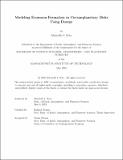Modeling Exomoon Formation in Circumplanetary Disks Using Dustpy
Author(s)
Noto, Maurielle I.
DownloadThesis PDF (2.366Mb)
Advisor
Teague, Richard
Terms of use
Metadata
Show full item recordAbstract
This study presents one-dimensional simulations of a viscously evolving, gas-starved circumplanetary disk (CPD) modeled around a Jupiter-like planet. The simulations investigate the conditions under which satellites may form, with a particular focus on identifying physical mechanisms that create pressure bumps and dust traps capable of triggering the streaming instability. Multiple simulations were conducted with injected dust particles having maximum sizes of 100 µm, 1 mm, and 1 cm, and with fragmentation velocities set to 100, 500, and 1000 cm/s. Results show that regardless of the initial maximum injection particle size, the CPD consistently evolves toward the same maximum grain size, 0.5 cm, driven by system-wide physical processes such as radial drift, gas-dust coupling, and fragmentation limits. Larger fragmentation velocities enable more rapid and extended particle growth, leading to earlier quasi-steady-state evolution and allowing grains to reach sizes beyond the fragmentation barrier in certain regions. An analysis of dust and gas radial velocity profiles was performed to examine the size-dependent dynamics of particles, offering insight into the evolving coupling between dust and gas across the disk. Although the simulations did not include dust back-reaction—thereby excluding the possibility of observing streaming instability—the framework establishes a baseline for future studies. Enabling back-reaction and incorporating substructures such as radial gaps would help identify localized regions of moon formation. These simulations also pave the way for further investigation into the roles of icelines and volatile transport in setting satellite composition and structure, contributing to a broader understanding of exomoon formation and habitability.
Date issued
2025-05Department
Massachusetts Institute of Technology. Department of Earth, Atmospheric, and Planetary SciencesPublisher
Massachusetts Institute of Technology